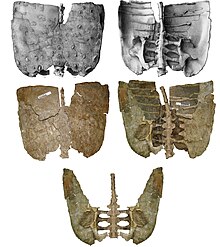폴라칸티나과
Polacanthinae| Polacanthines 시간 범위:후기 쥐라기-백악기 후기, 130–125 엄마 PreꞒ Ꞓ OSDCPTJKPg N↓. | |
|---|---|
 | |
| 골반 폴라 칸투스의 | |
| 과학적 분류 | |
| 왕국: | 애니멀리아 |
| Phylum: | 척색 동물문. |
| 계통 군: | 소공니아 |
| 주문: | †조반목 |
| 계통 군: | †장순아 목 |
| Suborder: | †곡룡류 |
| 가족: | †노도사우루스과 |
| Subfamily: | †폴라칸티나과 Lapparent&Lavocat, 1955년 [Madzia(알.][1] |
| Genera | |
| 동의어 해설[1] | |
| |
Polacanthinae는 어파 ankylosaurs 중에는 가장 자주 nodosaurids, 후기 쥐라기의 초기 백악기 유럽을 통해 및 잠재적으로 북미와 아시아.그 그룹은 노도 사우루스 textilis나 안킬로 사우루스 magniventris보다 가장 큰 clade 폴라 칸투스 foxii에 더 가까이 있는데, 그 그룹 중 Nodosauridae거나 안 킬로 사우루스과에 둥지들은 정의된다.만약 폴라 칸투스,와 규모에 의해 Polacanthinae 다음 -inae 접미사 부적절할 것family-level clade,었고, 그 그룹에 대한 적절한 이름이 비공식적으로 정의된 Polacanthidae를 벗어나는 것이다.[1]
Polacanthines보다 다소 더 가볍게 더 발달된 ankylosaurids과 nodosaurids보다 장갑 있었다.그들의 스파이크 덜 증원 콜라겐과 얇은 치밀골의 기갑 nodosaurids보다 만들어졌다.polacanthine 갑옷과 투구의 상대적 취약성은 이 방어로서 표시하기 위해 적었을 가능성이 있다.[2]그들은 땅으로 이어져 아시아와 북미 사이에 열린 같은 시간에 멸종된 것으로 보인다.[3]
분류
그 가족은 Polacanthidae 에른스트 Jaekel에 의해 1910년에 이로 인해 ankylosaurids과 nodosaurids 사이의 매개체를 보였다 ankylosaurs의 그룹을 참조에 임명되었다.이 그룹 대부분의 연구자들에 우리는 subfamily(Polacanthinae)로 커클랜드에 의해 자연스러운 그룹은 그의 1998년 분석은 폴라 칸투스, Charlotte서쪽의 도시., 그리고 Mymoorapelta 밀접하게 가족 안 킬로 사우루스과, 그리고로 추가 Hoplitosaurus과 힐라에오 사우루스 언급한 관련이 있는 방안을 제안함으로써 회복되었고 사용된 1990년대 후반까지 무시되었다.그 subfamily기 위해 그들이 너무 분석할 완벽하지 않았다.[4]케네쓰 카펜터 또한 그는 ankylosaurids에 nodosaurids보다 더 가까워지는데 그것은 유사한 그룹의 이름 Polacanthidae을 부활시켰다.카펜터는 공룡은 더 가까이 Charlotte서쪽의 도시.에서 S에드몬토니아 또는 유오플로케팔루스기보다 Polacanthidae을 정의하는 것이 되었다.[5]대부분의 후속 연구원들 원시적인 ankylosaurids로,더라도 엄격한 연구 대부분 없이 이 의견을 보여 주기 위해 polacanthines을 놓았다.'polacanthid의 관계의 최초의 포괄적인 연구를 2011년에 출판된 원시적인 nodosaurids의 역시 부자연한 그룹, 또는 유효한 어파 Nodosauridae의 기지에서 발견했습니다.[6]공식적으로 이 PhyloCode의 요건과 일치에 Polacanthinae를 정의하는 행동으로, Madzia와 동료들 양(알.(2013년)의 분석을 위해 Polacanthinae을 위해 일차 기준, 비슷한 결과 커클랜드(1998년)에 의해 발견되어 보완을 선택했다 톰슨 씨(알.(2012년), 아버(알.(2016년), Rivera-Sylva(알.(2018년), 정.(알.(2018년).[1][7][4][6][8][9][10]
| 노도사우루스과 |
| ||||||||||||||||||||||||||||||||||||||||||||||||||||||||||||||||||||||||||||||||||||||||||||||||||||||||||||||||||||||||||||||
클래드가 문헌에서 자주 언급되지만, 폴라칸틴으로 간주되는 대부분의 세자는 대신 폴라칸토스와 함께 자연 그룹을 형성하지 않는 것으로 밝혀져 원시 노도룡류, 원시 안킬로사우루스류 또는 노도사우루스과-안킬로사우루스과 외부를 대표한다.[1]In the analysis of Arbour et al. in 2016, and its subsequent modifications by Rivera-Sylva et al. and Zheng et al. in 2018, only Hoplitosaurus was resolved as a polacanthine alongside Polacanthus, with Peloroplites and Taohelong falling within Nodosaurinae, Gargoyleosaurus, Gastonia, and Mymoorapelta being more basal nodosaurids outside both subclades, 그리고 Hylaeosaurus는 일찍 전해지는 ankylosaurid를 나타낸다.[8][9][10]
참조
- ^ a b c d e Madzia, D.; Arbour, V.M.; Boyd, C.A.; Farke, A.A.; Cruzado-Caballero, P.; Evans, D.C. (2021). "The phylogenetic nomenclature of ornithischian dinosaurs". PeerJ. 9: e12362. doi:10.7717/peerj.12362.
- ^ Hayashi, S.; Carpenter, K.; Scheyer, T.M.; Watabe, M.; Suzuki, D. (2010). "Function and evolution of ankylosaur dermal armor" (PDF). Acta Palaeontologica Polonica. 55 (2): 213–228. doi:10.4202/app.2009.0103.
- ^ 커클랜드, J. I. (1996년)북미 서부의 백악기 중엽 파우나의 생물 지리학 - 유럽 관계의 상실과 최초의 아시아-북미 교류.J. 척추동물.고생톨. 16 (공급 3): 45A.
- ^ a b Kirkland, J.I. (1998). "A polacanthine ankylosaur (Ornithischia: Dinosauria) from the Early Cretaceous (Barremian) of eastern Utah". In Lucas, S.G.; Kirkland, J.I.; Estep, J.W. (eds.). Lower and Middle Cretaceous Terrestrial Ecosystems. New Mexico Museum of Natural History and Science Bulletin. Vol. 14. pp. 271–281.
- ^ Carpenter K (2001). "Phylogenetic analysis of the Ankylosauria". In Carpenter, Kenneth (ed.). The Armored Dinosaurs. Indiana University Press. pp. 455–484. ISBN 0-253-33964-2.
- ^ a b Thompson, R.S.; Parish, J.C.; Maidment, S.C.R.; Barrett, P.M. (2012). "Phylogeny of the ankylosaurian dinosaurs (Ornithischia: Thyreophora)". Journal of Systematic Palaeontology. 10 (2): 301–312. doi:10.1080/14772019.2011.569091.
- ^ Yang, J.; You, H.; Li, D.; Kong, D. (2013). "First discovery of polacanthine ankylosaur dinosaur in Asia". Vertebrata PalAsiatica. 51 (4): 265–277.
- ^ a b Arbour, V.M.; Zanno, L.E.; Gates, T. (2016). "Ankylosaurian dinosaur palaeoenvironmental associations were influenced by extirpation, sea-level fluctuation, and geodispersal". Palaeogeography, Palaeoclimatology, Palaeoecology. 449: 289–299. doi:10.1016/j.palaeo.2016.02.033.
- ^ a b Rivera-Sylva, H.E.; Frey, E.; Stinnesbeck, W.; Carbot-Chanona, G.; Sanchez-Uribe, I.E.; Guzmán-Gutiérrez, J.R. (2018). "Paleodiversity of Late Cretaceous Ankylosauria from Mexico and their phylogenetic significance". Swiss Journal of Palaeontology. 137: 83–93. doi:10.1007/s13358-018-0153-1.
- ^ a b Zheng, W.; Jin, X.; Azuma, Y.; Wang, Q.; Miyata, K.; Xu, X. (2018). "The most basal ankylosaurine dinosaur from the Albian–Cenomanian of China, with implications for the evolution of the tail club". Scientific Reports. 8: 3711. doi:10.1038/s41598-018-21924-7.




